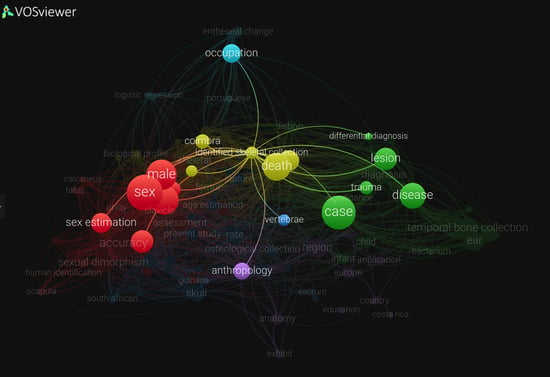The Scientific Profiles of Documented Collections via Publication Data: Past, Present, and Future Directions in Forensic Anthropology
Abstract
:1. Introduction
2. Materials and Methodological Approach
3. Results and Discussion
3.1. Publications Outputs and Trends
3.1.1. Geographical and Institutional Research Cooperation
3.1.2. Research Topics and Term Analysis
3.1.3. Citation Analysis and Co-Citation Analysis
3.2. TOP of the TOPs: The Four Journals with More Publications on DCs between 2010 and 2021
3.3. Profiling Documented Collections: Where, When, and How
“According to the regulations of the Municipal Cemetery of La Plata (Cementerio Municipal de La Plata, Ordenanza Municipal 7638/90), and in order to reuse space, individuals that have been buried for 6 years are exhumed by the cemetery personnel. [...] In 2002, and in compliance with the current legislation, the Administration of the Municipal Cemetery of La Plata decided to cede bones to the Faculty of Medicine at the National University of La Plata to be used for research and teaching purposes (Ordenanza Municipal 9471/02)”.(p. 276 of [62])
“Thus, in 1981 […] the HK Government entered into an informal collaboration with HKU to permit a long-term loan of exhumed skeletal remains of unclaimed individuals for teaching and research purposes […] HK Government may direct exhumation of any human remains that have been buried in public cemeteries for at least 6 years (Power of Authority to direct removal and disposal of human remains (Paragraph 119A), 1988) (accessed to HK e-Legislation database on 18th Nov2019 [e-Legislation, Last revision date: 18/12/, 2019])”.(p. 719 of [61])
“… the incorporation of human remains in the reference collection is that they have to be under the legal guardianship of the Chacarita Cemetery, which is the one that donates the remains to the project. The legal framework for this process is included in the articles of the Ordinance Number 27,590 (AD 480.1; BM 14.537) of the Government of Buenos Aires City (MCBA, 1973) that stipulate the procedure for the removal and disposal of human remains from the graves after use-rights have expired, usually after a period of 3–5 years, depending on the age of the deceased”.(p. 487 of [60])
4. Concluding Remarks: Moving Forward
Supplementary Materials
Author Contributions
Funding
Institutional Review Board Statement
Informed Consent Statement
Data Availability Statement
Acknowledgments
Conflicts of Interest
References
- Buikstra, J.E. Knowing your audience: Reactions to the human body, dead and undead. In Bioarchaeologists Speak Out; Bioarchaeology and Social Theory; Buisktra, J.E., Ed.; Springer: Cham, Switzerland, 2019; pp. 19–58. [Google Scholar]
- Emery, K.M.; Killgrove, K. Bones, bodies, and blogs: Outreach and engagement in bioarchaeology. Internet Archaeol. 2015. [CrossRef]
- Shelton, D.E.; Kim, Y.S.; Barak, G. A study of juror expectations and demands concerning scientific evidence: Does the “CSI Effect” exist? Vanderbilt JETLaw 2006, 9, 331–368. [Google Scholar]
- Kim, Y.S.; Barak, G.; Shelton, D.E. Examining the “CSI-effect” in the cases of circumstantial evidence and eyewitness testimony: Multivariate and path analyses. J. Crim. Justice 2009, 37, 452–460. [Google Scholar] [CrossRef]
- Black, S.M. Forensic anthropology–regulation in the United Kingdom. Sci. Justice J. Forensic Sci. Soc. 2003, 43, 187–192. [Google Scholar] [CrossRef]
- Cunha, E. Réflexion à propos de la popularité de l’anthropologie médico-légale aujourd’hui. Bull. Mem. Soc. Anthropol. Paris 2010, 22, 190–193. [Google Scholar] [CrossRef]
- Komar, D.A.; Buikstra, J.E. (Eds.) Forensic Anthropology: Contemporary Theory and Practice; Oxford University Press: Oxford, UK, 2008. [Google Scholar]
- Blau, S. More than just bare bones: Ethical considerations for forensic anthropologists. In Handbook of Forensic Anthropology and Archaeology; Blau, S., Ubelaker, D., Eds.; Left Coast Press: Walnut Creek, CA, USA, 2009; pp. 457–467. [Google Scholar]
- Henderson, C.; Alves-Cardoso, F. (Eds.) Identified Skeletal Collections: The Testing Ground of Anthropology? Archaeopress: Oxford, UK, 2018. [Google Scholar]
- Petaros, A.; Caplova, Z.; Verna, E.; Adalian, P.; Baccino, E.; de Boer, H.H.; Cunha, E.; Ekizoglu, O.; Ferreira, M.T.; Fracasso, T.; et al. Technical note: The Forensic Anthropology Society of Europe (FASE) map of identified osteological collections. Forensic Sci. Int. 2021, 328, 1–6. [Google Scholar] [CrossRef]
- Mann, R.W.; Koel-Abt, K.; Dhody, A.; Mahakkanukrauh, P.; Mann, V.J.; Techataweewan, N.; DeFreytas, J.R.; Ruengdit, S. The importance of human osteological collections: Our past, present, and future. Forensic Sci. Int. 2021, 325, 110895. [Google Scholar] [CrossRef]
- Santos, A.L. A particular heritage: The importance of identified osteological collections. Metode 2020, 10, 91–97. [Google Scholar] [CrossRef] [Green Version]
- Ross, A.H.; Pilloud, M. The need to incorporate human variation and evolutionary theory in forensic anthropology: A call for reform. Am. J. Phys. Anthropol. 2021, 176, 672–683. [Google Scholar] [CrossRef] [PubMed]
- Ross, A.H.; aams, S.E. Ancestry studies in forensic anthropology: Back on the frontier of racism. Biology 2021, 10, 602. [Google Scholar] [CrossRef]
- Obertová, Z.; Stewart, A.; Cattaneo, C. (Eds.) Statistics and Probability in Forensic Anthropology; Academic Press: London, UK, 2020. [Google Scholar]
- Franklin, D.; Blau, S. Physical and virtual sources of biological data in forensic anthropology: Considerations relative to practitioner and/or judicial requirements. In Statistics and Probability in Forensic Anthropology; Obertová, Z., Stewart, A., Cattaneo, C., Eds.; Academic Press: London, UK, 2020. [Google Scholar]
- De Carvalho, M.V.D.; Lira, V.F.; do Nascimento, E.A.; Torres Kobayashi, S.B.; de Araújo, L.F.; de Almeida, A.C.; Porto Petraki, G.G.; Cunha, E.; Soriano, E.P. New acquisitions of a contemporary Brazilian Identified Skeletal Collection. Forensic Sci. Int. Rep. 2020, 2, 100050. [Google Scholar] [CrossRef]
- Lopes, C.; Fernandes, T. The identified skeleton collection of Évora: Importance for forensic science and bioarchaeology in the southern inland of Portugal. Int. J. Leg. Med. 2021. [Google Scholar] [CrossRef]
- Ferreira, M.T.; Coelho, C.; Makhoul, C.; Navega, D.; Gonçalves, D.; Cunha, E.; Curate, F. New data about the 21st Century Identified Skeletal Collection (University of Coimbra, Portugal). Int. J. Leg. Med. 2021, 135, 1087–1104. [Google Scholar] [CrossRef] [PubMed]
- Mann, R.W.; Labrash, S.; Lozanoff, S. Medical school hotline: A new osteological resource at the John A. Burns School of Medicine. Hawai’I J. Health Soc. Wel. 2020, 79, 202–203. [Google Scholar]
- Marquez-Grant, N.; Fibiger, L. (Eds.) The Routledge Handbook of Archaeological Human Remains and Legislation: An International Guide to Laws and Practice in the Excavation and Treatment of Archaeological Human Remains; Routledge: London, UK, 2011. [Google Scholar]
- Squires, K.; Errickson, D.; Márquez-Grant, N. (Eds.) Ethical Approaches to Human Remains; Springer: Cham, Switzerland, 2019. [Google Scholar]
- Van Eck, N.J.; Waltman, L. Software survey: VOSviewer, a computer program for bibliometric mapping. Scientometrics 2010, 84, 523–538. [Google Scholar] [CrossRef] [PubMed] [Green Version]
- Pirsig, W.; Ulrich, R. Karl Wittmaack: His life, temporal bone collection, and publications. Arch Oto-Rhino-Laryngol. 1977, 217, 247–262. [Google Scholar] [CrossRef]
- Giraudi, R.; Fissore, F.; Giacobini, G. The collection of human skulls and postcranial skeletons at the Department of Human Anatomy of the University of Torino (Italy). Am. J. Phys. Anthropol. 1984, 65, 105–107. [Google Scholar] [CrossRef]
- Rother, P.; Krüger, G.; Schramek, G. Proportions of the femur and humerus in relation to bone length. Anat. Anz. 1985, 160, 65–76. [Google Scholar]
- Smith, D.R. Historical development of the journal impact factor and its relevance for occupational health. Ind. Health 2007, 45, 730–742. [Google Scholar] [CrossRef] [PubMed] [Green Version]
- Ugolini, D.; Bonassi, S.; Cristaudo, A.; Leoncini, G.; Ratto, G.B.; Neri, M. Temporal trend, geographic distribution, and publication quality in asbestos research. Environ. Sci. Pollut. Res. Int. 2015, 22, 6957–6967. [Google Scholar] [CrossRef]
- Chiu, W.T.; Ho, Y.S. Bibliometric analysis of tsunami research. Scientometrics 2007, 73, 3–17. [Google Scholar] [CrossRef]
- Brooks, S.; Suchey, J.M. Skeletal age determination based on the os pubis: A comparison of the Acsadi-Nemeskari and Suchey-Brooks methods. Hum. Evol. 1990, 5, 227–238. [Google Scholar] [CrossRef]
- Schuknecht, H.F.; Gacek, M.R. Cochlear pathology in presbycusis. Ann. Otol. Rhinol. Laryngol. 1993, 102, 1–16. [Google Scholar] [CrossRef] [PubMed]
- Fayad, J.N.; Linthicum, F.H. Multichannel cochlear implants: Relation of histopathology to performance. Laryngoscope 2006, 116, 1310–1320. [Google Scholar] [CrossRef] [PubMed]
- Hunt, D.R.; Albanese, J. History and demographic composition of the Robert J. Terry anatomical collection. Am. J. Phys. Anthropol. 2005, 127, 406–417. [Google Scholar] [CrossRef]
- Villotte, S.; Castex, D.; Couallier, V.; Dutour, O.; Knüsel, C.J.; Henry-Gambier, D. Enthesopathies as occupational stress markers: Evidence from the upper limb. Am. J. Phys. Anthropol. 2010, 142, 224–234. [Google Scholar] [CrossRef]
- De Pinillos, M.; Pantoja-Pérez, A.; Fernández-Colón, P.; Martín-Francés, L.; García-Campos, C.; Modesto-Mata, M.; Moreno-Torres, C.; Bermúdez de Castro, J.M.; Martinón-Torres, M. The Ratón Pérez collection: Modern deciduous human teeth at the Centro Nacional de Investigación sobre la Evolución Humana (Burgos, Spain). Am. J. Phys. Anthropol. 2021, 176, 528–535. [Google Scholar] [CrossRef]
- Tallman, S.D.; Blanton, A.I. Distal humerus morphological variation and sex estimation in modern Thai individuals. J. Forensic Sci. 2020, 65, 361–371. [Google Scholar] [CrossRef]
- Smith, D.E.M.; Humphrey, L.T.; Cardoso, H.F.V. Age estimation of immature human skeletal remains from mandibular and cranial bone dimensions in the postnatal period. Forensic Sci. Int. 2021, 327, 110943. [Google Scholar] [CrossRef]
- Del Bove, A.; Profico, A.; Riga, A.; Bucchi, A.; Lorenzo, C. A geometric morphometric approach to the study of sexual dimorphism in the modern human frontal bone. Am. J. Phys. Anthropol. 2020, 173, 643–654. [Google Scholar] [CrossRef]
- Lans, A.M. Decolonize this collection: Integrating black feminism and art to re-examine human skeletal remains in museums. Fem. Anthropol. 2021, 2, 130–142. [Google Scholar] [CrossRef]
- Squires, K.; Errickson, D.; Márquez-Grant, N. Introduction. In Ethical Approaches to Human Remains: A Global Challenge in Bioarchaeology and Forensic Anthropology; Squires, K., Errickson, D., Márquez-Grant, N., Eds.; Springer: Cham, Switzerland, 2019; pp. 1–18. [Google Scholar]
- Williams, S.; Ross, A.H. Ethical dilemmas in skeletal collection utilization: Implications of the Black Lives Matter movement on the anatomical and anthropological sciences. Anat. Rec. 2021. [Google Scholar] [CrossRef]
- Ferreira, M.T.; Vicente, R.; Navega, D.; Gonçalves, D.; Curate, F.; Cunha, E. A new forensic collection housed at the University of Coimbra, Portugal: The 21st century identified skeletal collection. Forensic Sci. Int. 2014, 245, 202.e1–5. [Google Scholar] [CrossRef] [PubMed] [Green Version]
- Milella, M.; Giovanna Belcastro, M.; Zollikofer, C.P.E.; Mariotti, V. The effect of age, sex, and physical activity on entheseal morphology in a contemporary Italian skeletal collection. Am. J. Phys. Anthropol. 2012, 148, 379–388. [Google Scholar] [CrossRef]
- Mahakkanukrauh, P.; Khanpetch, P.; Prasitwattanseree, S.; Vichairat, K.; Troy Case, D. Stature estimation from long bone lengths in a Thai population. Forensic Sci. Int. 2011, 210, 279.e1–7. [Google Scholar] [CrossRef]
- Franklin, D.; Cardini, A.; Flavel, A.; Kuliukas, A. The application of traditional and geometric morphometric analyses for forensic quantification of sexual dimorphism: Preliminary investigations in a Western Australian population. Int. J. Leg. Med. 2012, 126, 549–558. [Google Scholar] [CrossRef] [PubMed]
- Navega, D.; Vicente, R.; Vieira, D.N.; Ross, A.H.; Cunha, E. Sex estimation from the tarsal bones in a Portuguese sample: A machine learning approach. Int. J. Leg. Med. 2015, 129, 651–659. [Google Scholar] [CrossRef]
- Caple, J.M.; Byrd, J.E.; Stephan, C.N. The utility of elliptical Fourier analysis for estimating ancestry and sex from lateral skull photographs. Forensic Sci. Int. 2018, 289, 352–362. [Google Scholar] [CrossRef] [PubMed] [Green Version]
- Cardoso, H.F. Brief communication: The collection of identified human skeletons housed at the Bocage Museum (National Museum of Natural History), Lisbon, Portugal. Am. J. Phys. Anthropol. 2006, 129, 173–176. [Google Scholar] [CrossRef]
- Cardoso, H.F.V.; Marinho, L.; Caldas, I.M.; Puentes, K.; Andrade, M.; Toso, A.; Assis, S.; Magalhães, T. Historical, demographic, curatorial and legal aspects of the bonemedleg human skeletal reference collection (Porto, Portugal). Anthr. Anz. 2020, 77, 57–73. [Google Scholar] [CrossRef]
- Cardoso, H.F.V.; Marinho, L. Lost and then found: The Mendes Correia collection of identified human skeletons curated at the University of Porto, Portugal. Antropol. Port. 2016, 32–33, 29–46. [Google Scholar] [CrossRef] [Green Version]
- Alblas, A.; Greyling, L.M.; Geldenhuys, E.M. Composition of the Kirsten skeletal collection at Stellenbosch University. S. Afr. J. Sci. 2018, 114, 1–6. [Google Scholar] [CrossRef] [Green Version]
- Beresheim, A.C.; Pfeiffer, S.K.; Grynpas, M.D.; Alblas, A. Sex-specific patterns in cortical and trabecular bone microstructure in the Kirsten Skeletal Collection, South Africa. Am. J. Hum. Biol. 2018, 30, e23108. [Google Scholar] [CrossRef]
- Komar, D.A.; Grivas, C. Manufactured populations: What do contemporary reference skeletal collections represent? A comparative study using the Maxwell Museum documented collection. Am. J. Phys. Anthropol. 2008, 137, 224–233. [Google Scholar] [CrossRef] [PubMed]
- Techataweewan, N.; Tuamsuk, P.; Toomsan, Y.; Woraputtaporn, W.; Prachaney, P.; Tayles, N. A large modern Southeast Asian human skeletal collection from Thailand. Forensic Sci. Int. 2017, 278, 406.e1–406.e6. [Google Scholar] [CrossRef]
- Techataweewan, N.; Panthongviriyakul, C.; Toomsan, Y.; Mothong, W.; Kanla, P.; Chaichun, A.; Amarttayakong, P.; Tayles, N. Human body donation in Thailand: Donors at Khon Kaen University. Ann. Anat. 2018, 216, 142–151. [Google Scholar] [CrossRef]
- Cunha, E.; Lopez-Capp, T.T.; Inojosa, R.; Marques, S.R.; Moraes, L.O.C.; Liberti, E.; Machado, C.E.P.; de Paiva, L.A.S.; Francesquini Júnior, L.; Daruge Junior, E.; et al. The Brazilian identified human osteological collections. Forensic Sci. Int. 2018, 289, 449.e1–449.e6. [Google Scholar] [CrossRef] [PubMed]
- Alemán, I.; Irurita, J.; Valencia, A.R.; Martínez, A.; López-Lázaro, S.; Viciano, J.; Botella, M.C. Brief communication: The Granada osteological collection of identified infants and young children. Am. J. Phys. Anthropol. 2012, 149, 606–610. [Google Scholar] [CrossRef]
- Cattaneo, C.; Mazzarelli, D.; Cappella, A.; Castoldi, E.; Mattia, M.; Poppa, P.; de Angelis, D.; Vitello, A.; Biehler-Gomez, L. A modern documented Italian identified skeletal collection of 2127 skeletons: The CAL Milano Cemetery Skeletal Collection. Forensic Sci. Int. 2018, 287, 219.e1–219.e5. [Google Scholar] [CrossRef] [PubMed]
- Le Luyer, M.; Bayle, P. The Tooth Fairy collection (la collection Petite Souris), a sample of documented human deciduous teeth at the University of Bordeaux, France. Am. J. Biol. Anthropol. 2021, 177, 175–181. [Google Scholar] [CrossRef]
- Bosio, L.A.; García Guraieb, S.; Luna, L.H.; Aranda, C. Chacarita Project: Conformation and analysis of a modern and documented human osteological collection from Buenos Aires City–theoretical, methodological and ethical aspects. HOMO 2012, 63, 481–492. [Google Scholar] [CrossRef] [PubMed]
- Savoldi, F.; Montalvao, C.; Hui, L.; Leung, C.K.K.; Jablonski, N.G.; Tsoi, J.K.H.; Bornstein, M.M. The Human Bone Collection of the Faculty of Dentistry at the University of Hong Kong: History and description of cranial and postcranial skeletal remains. Am. J. Phys. Anthropol. 2021, 175, 718–730. [Google Scholar] [CrossRef] [PubMed]
- Salceda, S.A.; Desántolo, B.; Mancuso, R.G.; Plischuk, M.; Inda, A.M. The “Prof. Dr. Rómulo Lambre” Collection: An Argentinian sample of modern skeletons. HOMO 2012, 63, 275–281. [Google Scholar] [CrossRef]
- Alves Cardoso, F. “Not of one’s body”: The creation of identified skeletal collections with Portuguese human remains. In Ethical Approaches to Human Remains: A Global Challenge in Bioarchaeology and Forensic Anthropology; Squires, K., Errickson, D., Márquez-Grant, N., Eds.; Springer: Cham, Switzerland, 2019; pp. 503–518. [Google Scholar]
- Maass, P.; Friedling, L.J. Documented composition of cadaveric skeletal remains in the University of Cape Town Human Skeletal Collection, South Africa. Forensic Sci. Int. 2019, 294, 219.e1–219.e7. [Google Scholar] [CrossRef] [PubMed]
- Muller, J.L.; Pearlstein, K.E.; de la Cova, C. Dissection and documented skeletal collections: Embodiments of legalized inequality. In The Bioarchaeology of Dissection and Autopsy in the United States; Bioarchaeology and Social Theory; Nystrom, K., Ed.; Springer: Cham, Switzerland, 2017; pp. 185–201. [Google Scholar]
- Bright, L.N. Structural violence: Epistemological considerations for bioarchaeology. In Theoretical Approaches in Bioarchaeology; Cheverko, C.M., Prince-Buitenhuys, J.R., Hubbe, M., Eds.; Routledge: New York, NY, USA, 2020; pp. 130–131. [Google Scholar] [CrossRef]
- Nystrom, K.C. The bioarchaeology of structural violence and dissection in the 19th-century United States. Am. Anthropol. 2016, 116, 765–779. [Google Scholar] [CrossRef]
- Watkins, R.J. The fate of anatomical collections in the US: Bioanthropological investigations of structural violence. In Identified Skeletal Collections: The Testing Ground of Anthropology? Henderson, C., Alves-Cardoso, F., Eds.; Archaeopress: Oxford, UK, 2018; pp. 169–186. [Google Scholar]
- Zuckerman, M.K.; Austin, R.M.; Hofman, C.A. Historical anatomical collections of human remains: Exploring their reinterpretation as representations of racial violence. Ann. Am. Acad. Polit. Soc. 2021, 694, 39–47. [Google Scholar] [CrossRef]
- De La Cova, C. Processing the destitute and deviant dead: Inequality, dissection, politics, and the structurally violent legalization of social marginalization in American anatomical collections. In The Poetics of Processing: Memory Formation, Identity, and the Handling of the Dead; Osterholtz, A.J., Ed.; University Press of Colorado: Boulder, CO, USA, 2020; pp. 212–234. [Google Scholar]
- De la Cova, C. Making silenced voices speak: Restoring neglected and ignored identities in anatomical collections. In Theoretical Approaches in Bioarchaeology; Cheverko, C.M., Prince-Buitenhuys, J.R., Hubbe, M., Eds.; Routledge: New York, NY, USA, 2020; pp. 150–170. [Google Scholar]
- Boucherie, A.; Polet, C.; Lefèvre, P.; Vercauteren, M. Sexing the bony labyrinth: A morphometric investigation in a subadult and adult Belgian identified sample. J. Forensic Sci. 2021, 66, 808–820. [Google Scholar] [CrossRef]
- Chi-Keb, J.R.; Albertos-González, V.M.; Ortega-Muñoz, A.; Tiesler, V.G. A new reference collection of documented human skeletons from Mérida, Yucatan, Mexico. HOMO 2013, 64, 366–376. [Google Scholar] [CrossRef]
- Dayal, M.R.; Kegley, A.D.; Štrkalj, G.; Bidmos, M.A.; Kuykendall, K.L. The history and composition of the Raymond A. Dart Collection of human skeletons at the University of the Witwatersrand, Johannesburg, South Africa. Am. J. Phys. Anthropol. 2009, 140, 324–335. [Google Scholar] [CrossRef]
- Eliopoulos, C.; Lagia, A.; Manolis, S. A modern, documented human skeletal collection from Greece. HOMO 2007, 58, 221–228. [Google Scholar] [CrossRef]
- Belcastro, M.G.; Bonfiglioli, B.; Pedrosi, M.E.; Zuppello, M.; Tanganelli, V.; Mariotti, V. The History and Composition of the identified human skeletal collection of the Certosa cemetery (Bologna, Italy, 19th–20th Century). Int. J. Osteoarchaeol. 2007, 27, 912–925. [Google Scholar] [CrossRef]
- Go, M.C.; Lee, A.B.; Santos, J.A.D.; Vesagas, N.M.C.; Crozier, R. A newly assembled human skeletal reference collection of modern and identified Filipinos. Forensic Sci. Int. 2017, 271, 128-e1. [Google Scholar] [CrossRef]
- L’Abbé, E.N.; Loots, M.; Meiring, J.H. The Pretoria bone collection: A modern South African skeletal sample. HOMO 2005, 56, 197–205. [Google Scholar] [CrossRef] [PubMed]
- Nikita, E. Documented skeletal collections in Greece: Composition, research, and future prospects. Am. J. Phys. Anthropol. 2020, 174, 140–143. [Google Scholar] [CrossRef]
- Sanabria-Medina, C.; Gonzalez-Colmenares, G.; Restrepo, H.O.; Rodríguez, J.M.G. A contemporary Colombian skeletal reference collection: A resource for the development of population specific standards. Forensic Sci. Int. 2016, 266, 577-e1. [Google Scholar] [CrossRef]
- Rocha, M.A. Les collections ostéologiques humaines identifiées du Musée Anthropologique de l’Université de Coimbra. Antropol. Port. 1995, 13, 7–38. [Google Scholar]
- Joyce, R.A. Science, objectivity, and academic freedom in the twenty-first century. Int. J. Cult. Prop. 2021, 28, 193–199. [Google Scholar] [CrossRef]
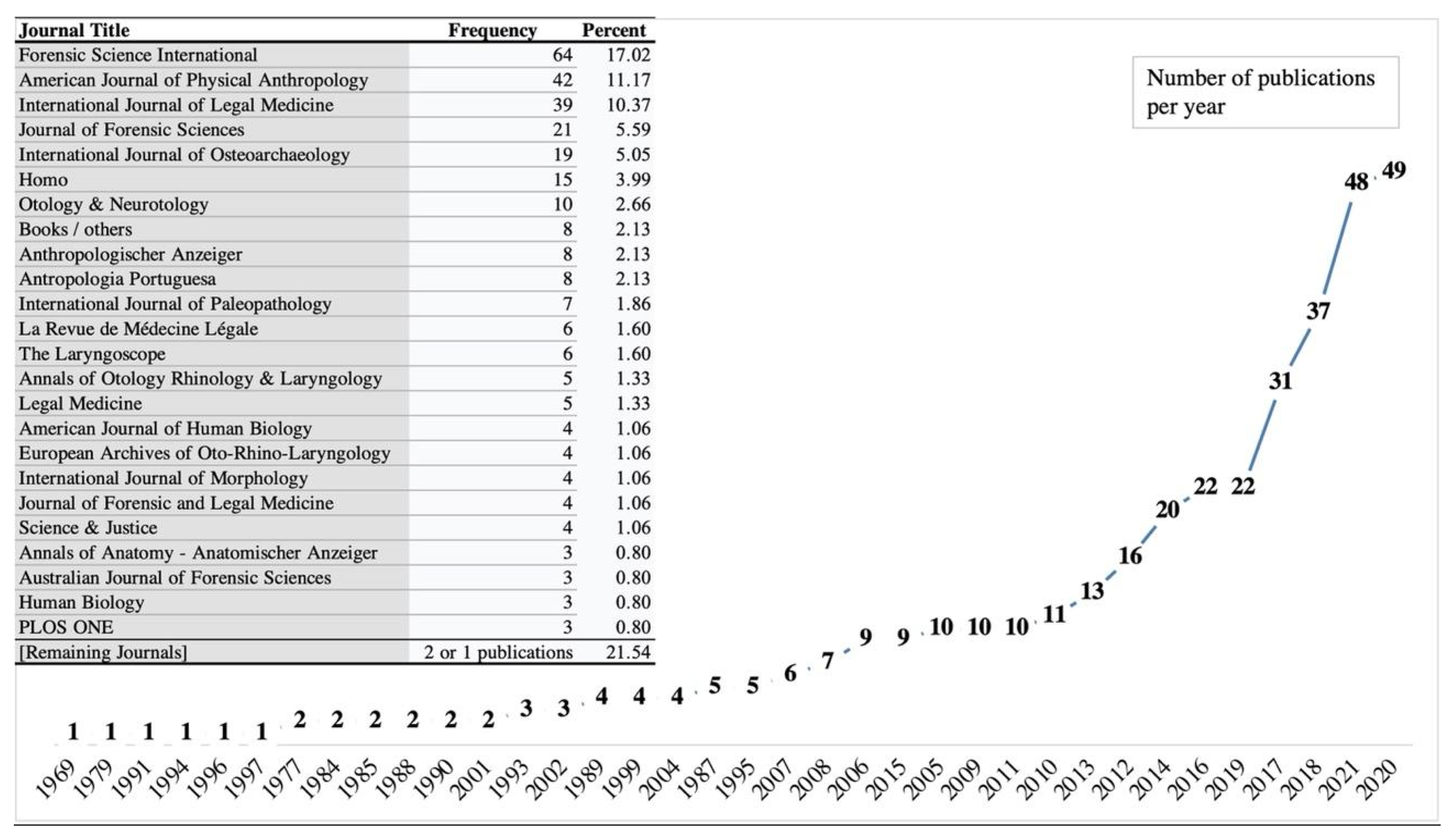
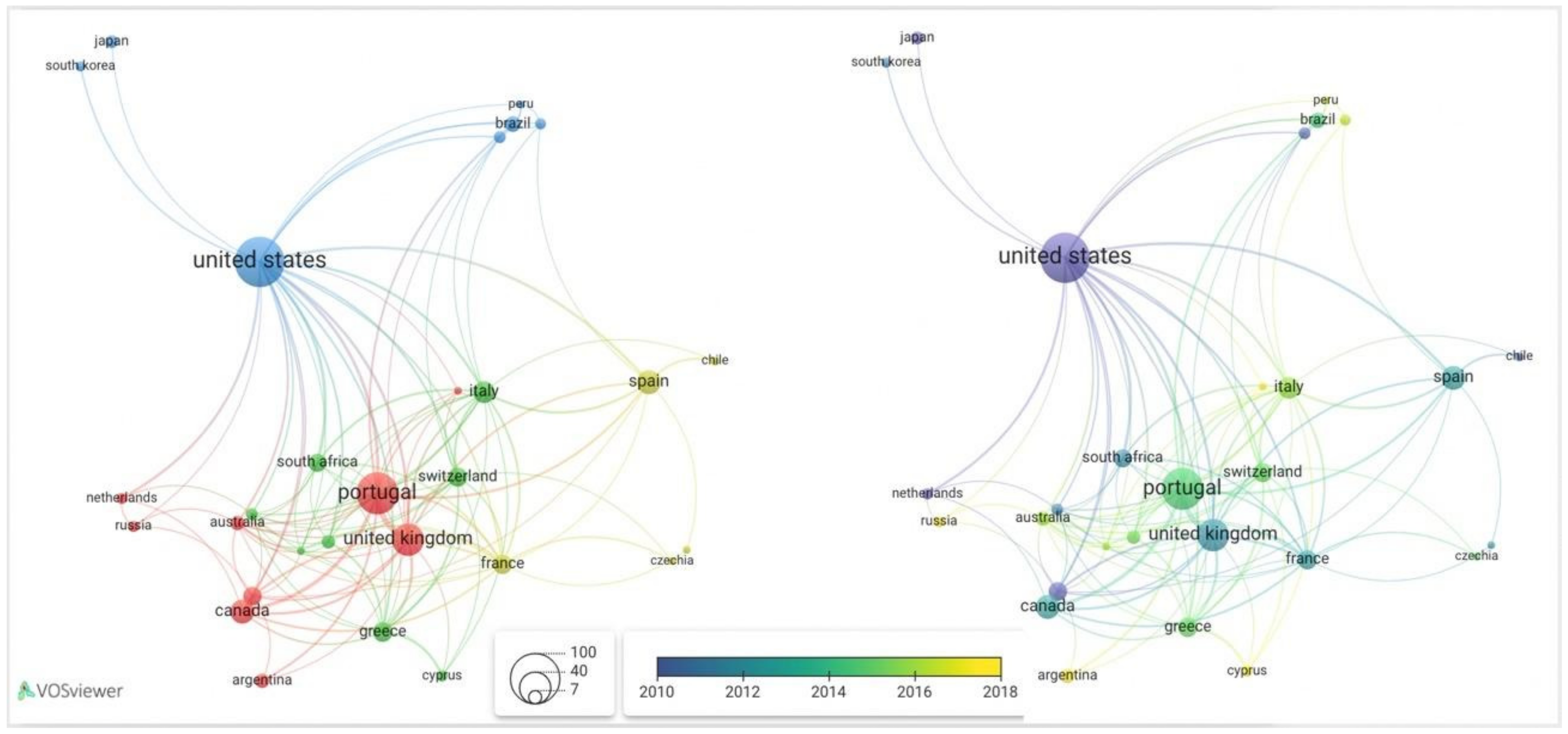
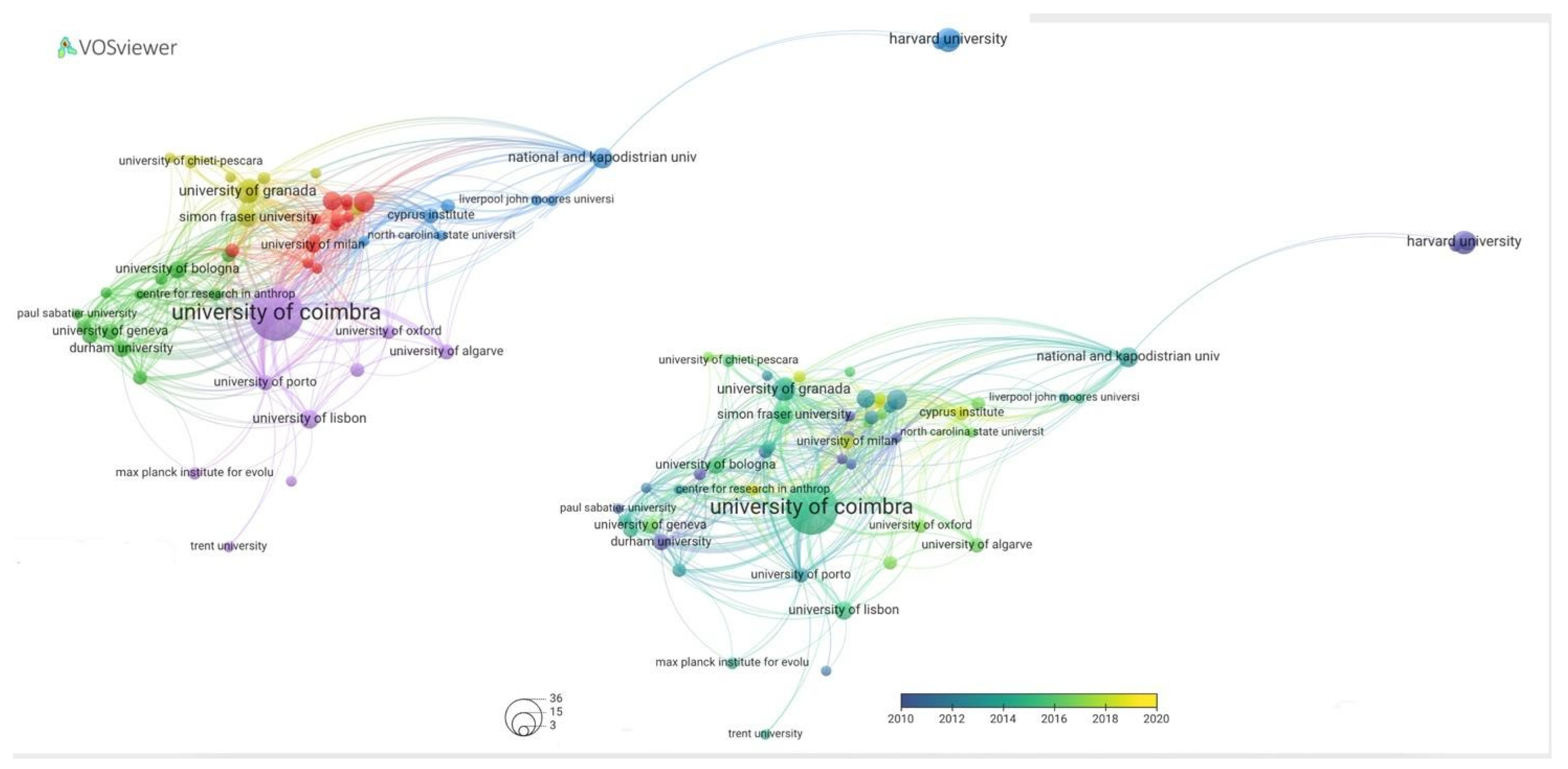
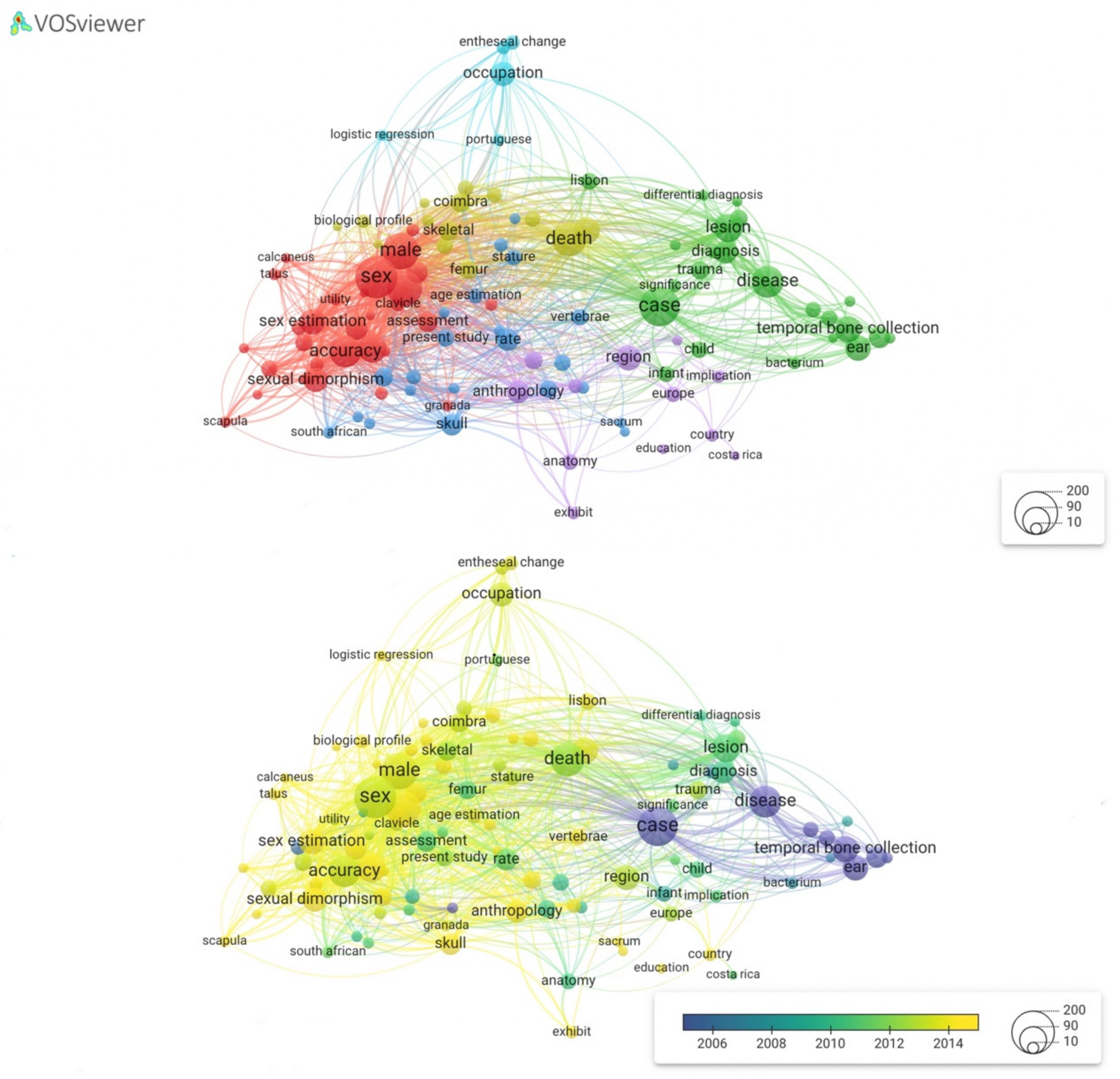
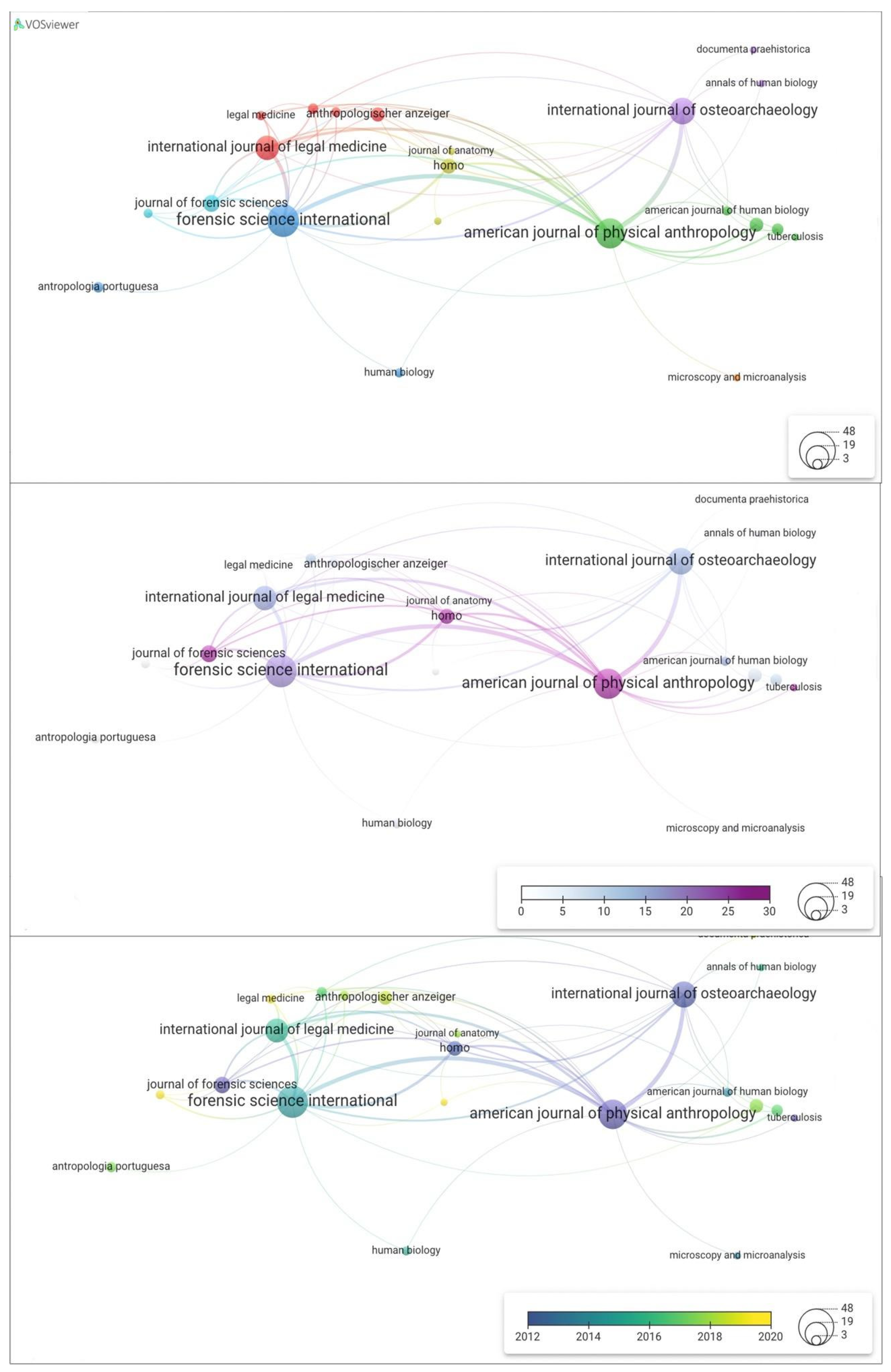
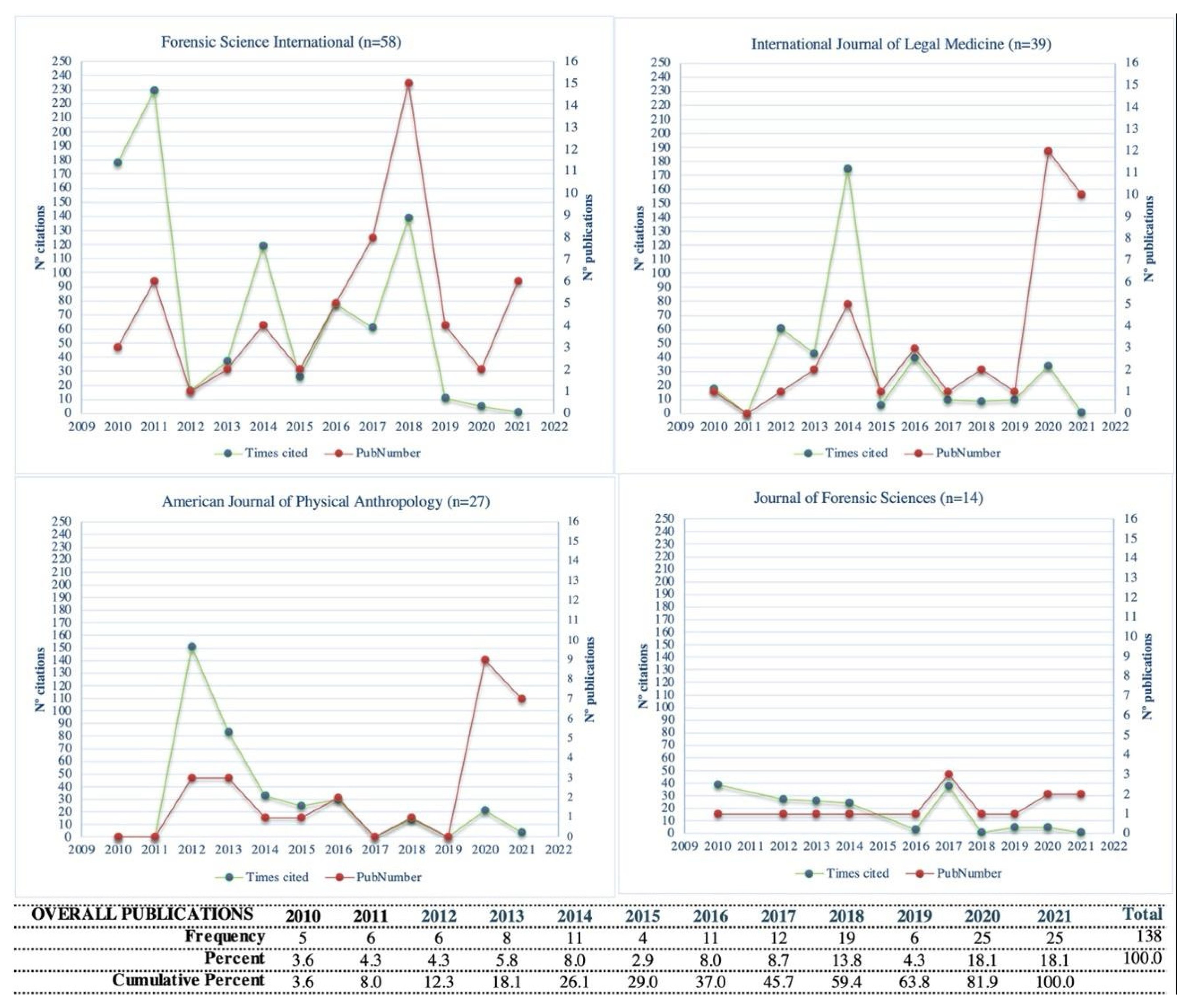
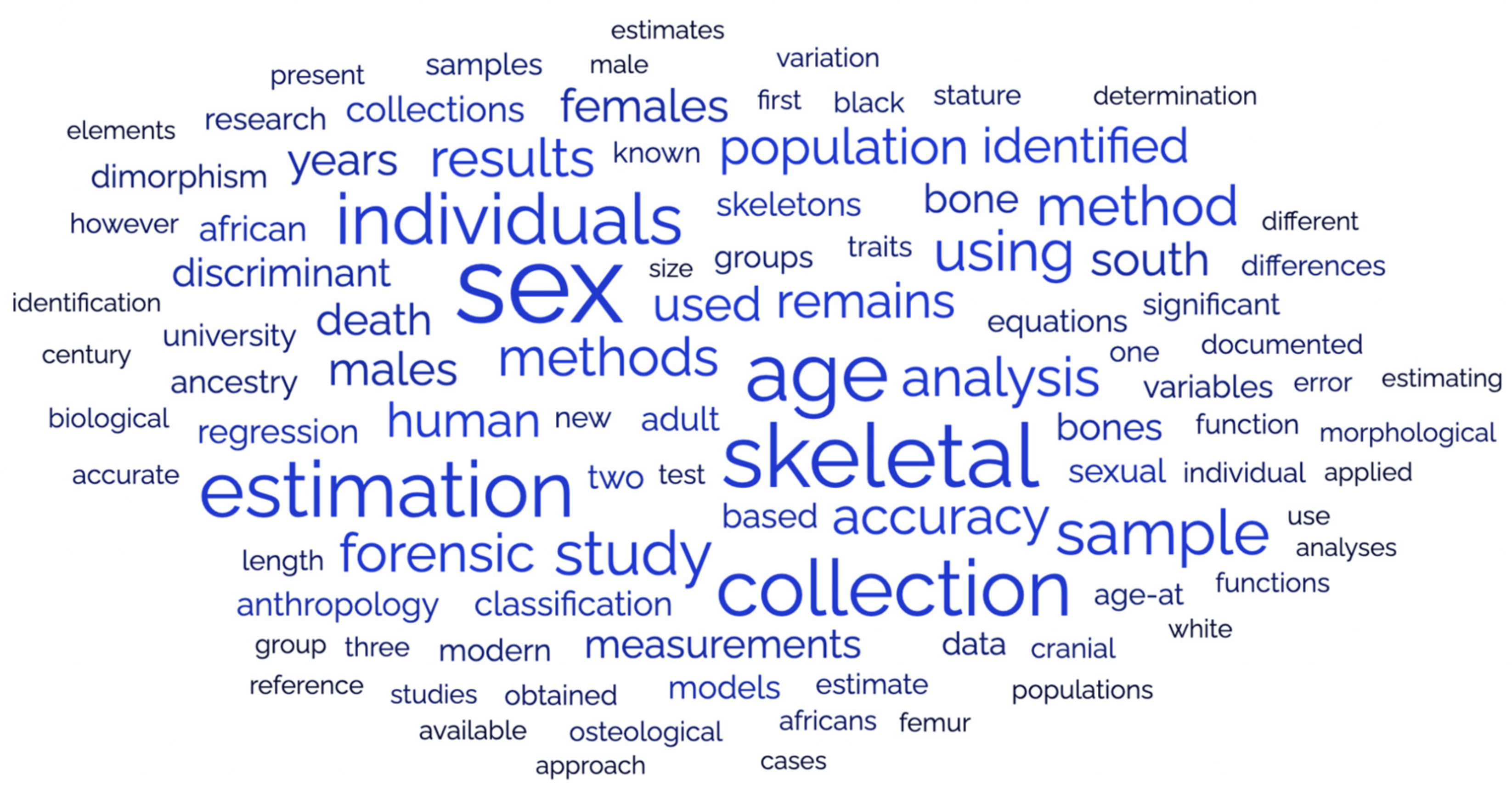
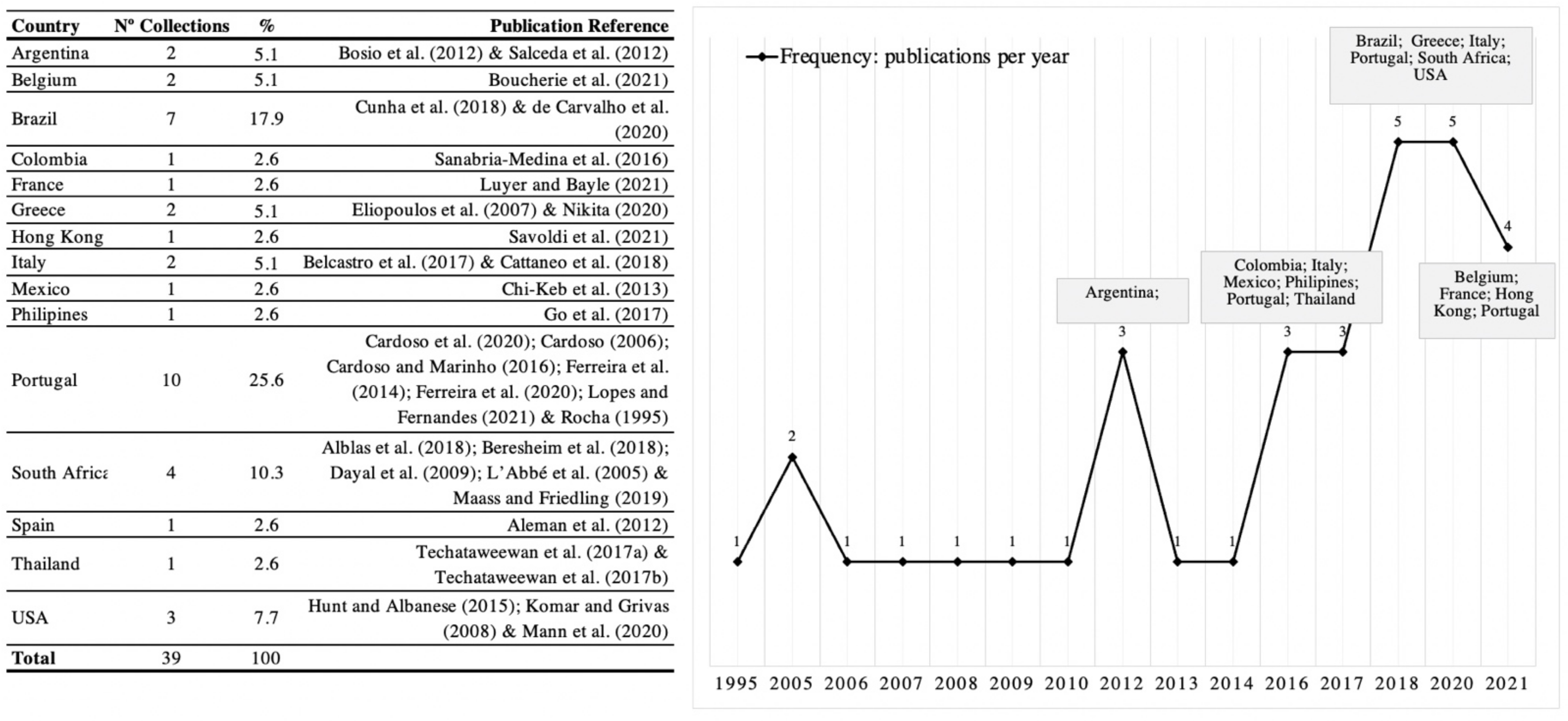
| Article Title (Most Cited) | Authors | Journal Title | Year of Publication | Citation Number * | Altmetric Attention Score * |
|---|---|---|---|---|---|
| Skeletal age determination based on the os pubis: A comparison of the Acsádi-Nemeskéri and Suchey-Brooks methods | Brooks and Suchey [30] | Human Evolution | 1990 | 1118 | 7 |
| Cochlear Pathology in Presbycusis | Schuknecht and Gacek [31] | Annals of Otology, Rhinology, and Laryngology | 1993 | 546 | 6 |
| Multichannel Cochlear Implants: Relation of Histopathology to Performance | Fayad and Linthicum [32] | The Laryngoscope | 2006 | 176 | |
| History and demographic composition of the Robert J. Terry anatomical collection | Hunt and Albanese [33] | American Journal of Physical Anthropology | 2005 | 162 | 10 |
| Enthesopathies as occupational stress markers: Evidence from the upper limb | Villotte et al. [34] | American Journal of Physical Anthropology | 2009 | 158 | 4 |
| Article Title (highest Altmetric Score) | Journal Title | Year of Publication | Citation Number | Altmetric Attention Score | |
| The Ratón Pérez collection: Modern deciduous human teeth at the Centro Nacional de Investigación sobre la Evolución Humana (Burgos, Spain) | de Pinillos et al. [35] | American Journal of Physical Anthropology | 2021 | 0 | 75 |
| Distal Humerus Morphological Variation and Sex Estimation in Modern Thai Individuals | Tallman and Blanton [36] | Journal of Forensic Sciences | 2019 | 5 | 44 |
| Age estimation of immature human skeletal remains from mandibular and cranial bone dimensions in the postnatal period | Smith et al. [37] | Forensic Science International | 2021 | 0 | 24 |
| Decolonize this collection: Integrating black feminism and art to re-examine human skeletal remains in museums | Lans [39] | Feminist Anthropology | 2020 | 3 | 20 |
| A geometric morphometric approach to the study of sexual dimorphism in the modern human frontal bone | Del Bove et al. [38] | American Journal of Physical Anthropology | 2020 | 1 | 17 |
| Article Title | Authors | Journal Title | Year of Publication | Citation Number * | Altmetric Attention Score * |
|---|---|---|---|---|---|
| The effect of age, sex, and physical activity on entheseal morphology in a contemporary Italian skeletal collection | Milella et al. [43] | American Journal of Physical Anthropology | 2012 | 95 | 3 |
| Stature estimation from long bone lengths in a Thai population | Mahakkanukrauh et al. [44] | Forensic Science International | 2011 | 83 | |
| A new forensic collection housed at the University of Coimbra, Portugal: The 21st century identified skeletal collection | Ferreira et al. [42] | Forensic Science International | 2014 | 68 | 1 |
| The application of traditional and geometric morphometric analyses for forensic quantification of sexual dimorphism: preliminary investigations in a Western Australian population | Franklin et al. [45] | International Journal of Legal Medicine | 2012 | 61 | |
| Sex estimation from the tarsal bones in a Portuguese sample: a machine learning approach | Navega et al. [46] | International Journal of Legal Medicine | 2014 | 47 | |
| Article Title | Authors | Journal Title (impact factor) | Year of Publication | Citation Number * | Altmetric Attention Score * |
| The Ratón Pérez collection: Modern deciduous human teeth at the Centro Nacional de Investigación sobre la Evolución Humana (Burgos, Spain) | de Pinillos et al. [35] | American Journal of Physical Anthropology | 2021 | 0 | 75 |
| Distal Humerus Morphological Variation and Sex Estimation in Modern Thai Individuals | Tallman and Blanton [36] | Journal of Forensic Sciences | 2019 | 5 | 44 |
| Age estimation of immature human skeletal remains from mandibular and cranial bone dimensions in the postnatal period | Smith et al. [37] | Forensic Science International | 2021 | 0 | 24 |
| A geometric morphometric approach to the study of sexual dimorphism in the modern human frontal bone | Del Bove et al. [38] | American Journal of Physical Anthropology | 2020 | 1 | 17 |
| The utility of elliptical Fourier analysis for estimating ancestry and sex from lateral skull photographs | Caple et al. [47] | Forensic Science International | 2018 | 8 | 13 |
Publisher’s Note: MDPI stays neutral with regard to jurisdictional claims in published maps and institutional affiliations. |
© 2022 by the authors. Licensee MDPI, Basel, Switzerland. This article is an open access article distributed under the terms and conditions of the Creative Commons Attribution (CC BY) license (https://creativecommons.org/licenses/by/4.0/).
Share and Cite
Alves-Cardoso, F.; Campanacho, V. The Scientific Profiles of Documented Collections via Publication Data: Past, Present, and Future Directions in Forensic Anthropology. Forensic Sci. 2022, 2, 37-56. https://doi.org/10.3390/forensicsci2010004
Alves-Cardoso F, Campanacho V. The Scientific Profiles of Documented Collections via Publication Data: Past, Present, and Future Directions in Forensic Anthropology. Forensic Sciences. 2022; 2(1):37-56. https://doi.org/10.3390/forensicsci2010004
Chicago/Turabian StyleAlves-Cardoso, Francisca, and Vanessa Campanacho. 2022. "The Scientific Profiles of Documented Collections via Publication Data: Past, Present, and Future Directions in Forensic Anthropology" Forensic Sciences 2, no. 1: 37-56. https://doi.org/10.3390/forensicsci2010004
APA StyleAlves-Cardoso, F., & Campanacho, V. (2022). The Scientific Profiles of Documented Collections via Publication Data: Past, Present, and Future Directions in Forensic Anthropology. Forensic Sciences, 2(1), 37-56. https://doi.org/10.3390/forensicsci2010004






